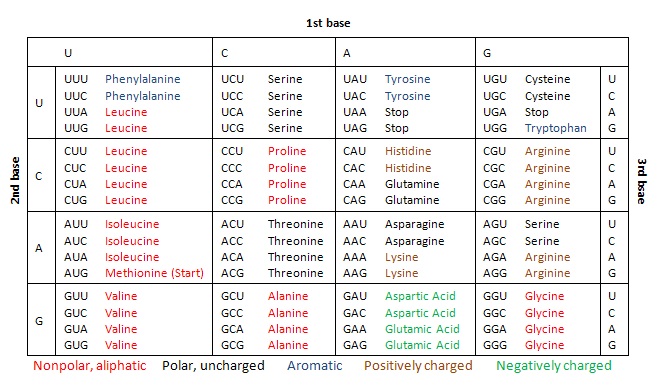Computation Genomics
Central Dogma of Biology
DNA: DNA is the genetic code
- A, C, G, T
- DNA is transcribed into RNA in a sequence dependent fashion
Messenger RNA: DNA is converted through a process called transcription to what’s called messenger RNA
- A, C, G, U
- three letters constitute what’s called a codon
- a codon encode for one amino acid
- messenger RNA is read 3 letters at a time to give you the different amino acids that make up the proteins
- It’s the sequential non-overlapping reading of the sequence
Proteins: Messenger RNA is converted to proteins
- Proteins are composed of amino acids
Complementary Bases
- Say we have a DNA sequence
- a DNA strand: ATG ATC TCG TAA
- DNA has a direction, adding 5’ end and 3’ end: 5’ ATG ATC TCG TAA 3’
- Can have the other strand of DNA going back the other way with complimentary bases
- C <-> G
- T <-> A
- Once we have one strand, we can always calculate the other:
When transcription happens, it opens the DNA strand to top and bottom
Full DNA strand:
- Top strand: 5’ ATG ATC TCG TAA 3’
- Bottom strand: 3’ TAC TAG AGC ATT 5’
a RNA is made by template strand
- T -> A
- A -> U
- C <-> G
Full RNA strand:
- Coding strand: 5’ ATG ATC TCG TAA 3’
- Template strand: 3’ AUG AUC UCG UAA 5’
Condon Table
 condon table
condon table- So for AUG, it refers to Methionine
Sequence a Genome
How big is a human Genome?
- Human Genome: 3.1 billion base pairs 3.1Gbp
- Bacteria Genome: 2 millon bp 2Mbp
Sequencing
- Sequencing the genome: Understanding and deciphering the order of A, G, C, T in the genomes
- Although human genome has 3.1 Gbp, it’s only a combination of 4 bases: A,G,C,T
What is genome sequencing
- Bacteria: mostly circular genome
Some Sequencing Terms
- Open Reading Frame ORF: A stretch of amino acids with no stop codon
- Coding Sequence CDS: An ORF that could encode a protein
- Protein encoding gene PEG” An gene that could encode a protein
- Hypothetical protein: Something that has not been experimentally shown
- Polypeptide: A short stretch of amino acids typicallyabout20aminoacidsorless
- Contig: A contiguous piece of DNA sequence that has been assembled from more than one reads. It is compiled because, as noted above, the 5’ end of one sequence overlaps the 3’ end of another.
- Read: The unit of DNA sequence that comes from a sequencing instrument. A single piece of DNA sequence.


